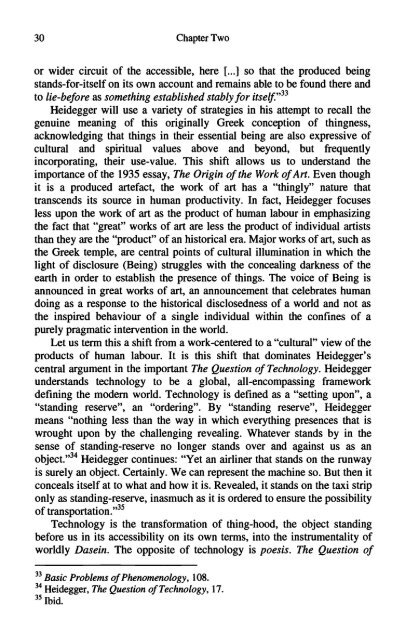Sartre's second century
Sartre's second century
Sartre's second century
Create successful ePaper yourself
Turn your PDF publications into a flip-book with our unique Google optimized e-Paper software.
30 Chapter Two<br />
or wider circuit of the accessible, here [...] so that the produced being<br />
stands-for-itself on its own account and remains able to be found there and<br />
to lie-before as something established stably for itself" 33<br />
Heidegger will use a variety of strategies in his attempt to recall the<br />
genuine meaning of this originally Greek conception of thingness,<br />
acknowledging that things in their essential being are also expressive of<br />
cultural and spiritual values above and beyond, but frequently<br />
incorporating, their use-value. This shift allows us to understand the<br />
importance of the 1935 essay, The Origin of the Work of Art. Even though<br />
it is a produced artefact, the work of art has a "thingly" nature that<br />
transcends its source in human productivity. In fact, Heidegger focuses<br />
less upon the work of art as the product of human labour in emphasizing<br />
the fact that "great" works of art are less the product of individual artists<br />
than they are the "product" of an historical era. Major works of art, such as<br />
the Greek temple, are central points of cultural illumination in which the<br />
light of disclosure (Being) struggles with the concealing darkness of the<br />
earth in order to establish the presence of things. The voice of Being is<br />
announced in great works of art, an announcement that celebrates human<br />
doing as a response to the historical disclosedness of a world and not as<br />
the inspired behaviour of a single individual within the confines of a<br />
purely pragmatic intervention in the world.<br />
Let us term this a shift from a work-centered to a "cultural" view of the<br />
products of human labour. It is this shift that dominates Heidegger's<br />
central argument in the important The Question of Technology. Heidegger<br />
understands technology to be a global, all-encompassing framework<br />
defining the modern world. Technology is defined as a "setting upon", a<br />
"standing reserve", an "ordering". By "standing reserve", Heidegger<br />
means "nothing less than the way in which everything presences that is<br />
wrought upon by the challenging revealing. Whatever stands by in the<br />
sense of standing-reserve no longer stands over and against us as an<br />
object." 34 Heidegger continues: "Yet an airliner that stands on the runway<br />
is surely an object. Certainly. We can represent the machine so. But then it<br />
conceals itself at to what and how it is. Revealed, it stands on the taxi strip<br />
only as standing-reserve, inasmuch as it is ordered to ensure the possibility<br />
of transportation." 35<br />
Technology is the transformation of thing-hood, the object standing<br />
before us in its accessibility on its own terms, into the instrumentality of<br />
worldly Dasein. The opposite of technology is poesis. The Question of<br />
Basic Problems of Phenomenology, 108.<br />
34 Heidegger, The Question of Technology, 17.<br />
35 Ibid.
















